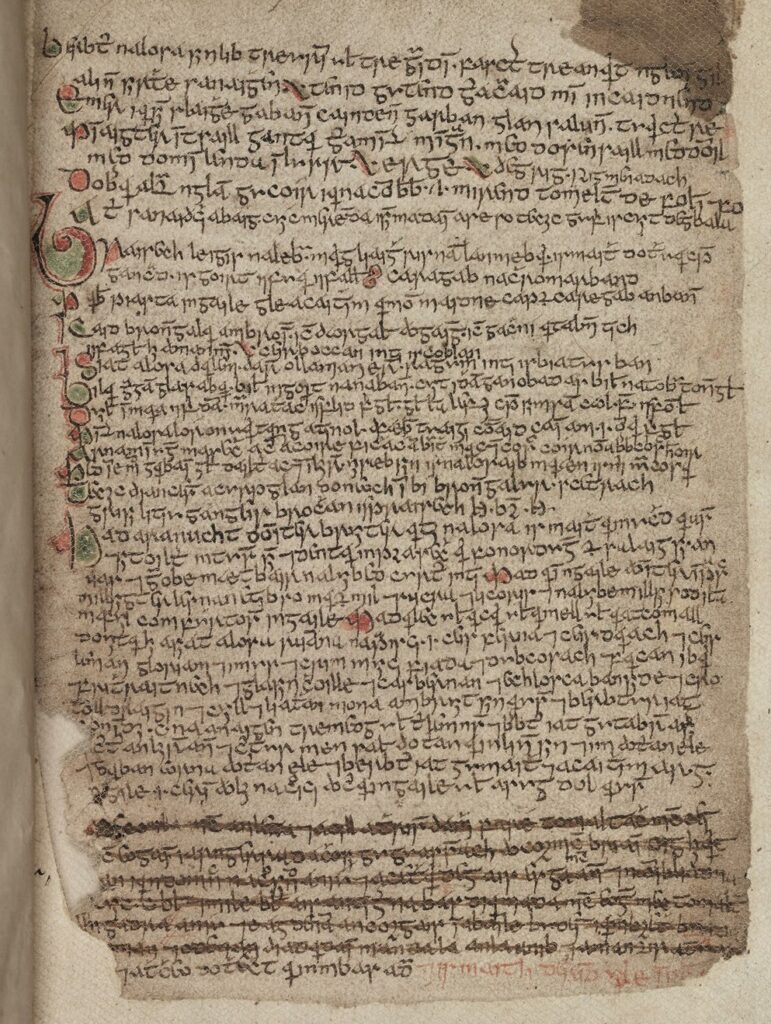Dublin, Royal Irish Academy MS 23 N 29 (467)
Deborah Hayden

Figure 1: Dublin, Royal Irish Academy MS 23 N 29, fol. 4r: a page from Conla Mac an Leagha’s prosimetrical remedy collection, followed by a note concerning the scribe’s whereabouts. Image courtesy of Irish Script on Screen.
This paper manuscript of 105 folios is a good illustration of the complexities involved in tracing the evidence for premodern Irish medical writing: the codex in fact consists of 23 separate fragments written between the sixteenth and eighteenth centuries, many of them bound out of order. The most recent collation of the manuscript reveals, however, that some of these fragments combine to make complete texts; for example, fragments 17 and 21 constitute a single series of hexameters on diet with Irish commentary, while fragments 9, 10 and 14 constitute a single treatise on medicaments and doses. As one might expect in such a source, the contents of the manuscript are extremely varied. In addition to these two treatises, for example, there are two separate Irish translations of the Aphorisms of Hippocrates; a Materia medica; and an Irish translation of the widely circulated treatise on uroscopy by the twelfth-century French physician Gilles de Corbeil (Aegidius).
Some of the contents of RIA MS 23 N 29 can be connected to other extant Irish medical manuscripts. The first nine leaves contain part of a large prosimetrical collection of medical remedies, containing over 920 cures, charms and prayers, that was compiled by the Connacht physician Conla Mac an Leagha around the turn of the sixteenth century, seemingly drawing on much earlier material (Hayden 2022). Conla was a member of a well-known hereditary medical family based in North Connacht (Walsh 1947) and was the principal scribe of RIA MS 24 B 3, where the majority of this remedy collection, the rest of which is written on vellum, survives (see our Manuscript of the Month entry for February 2024). The treatise as a whole is arranged in typical head-to-toe order; the portion of the text preserved in RIA MS 23 N 29 consists mainly of remedies for afflictions of the stomach and kidneys, andrological ailments (on which see Hayden 2021) and women’s ailments, and it appears that these paper leaves once formed part of the sixth quire of the original manuscript, in which only the outer and central bifolia were of vellum (Nic Dhonnchadha 2019: 117).
Another surviving medical manuscript that has contents in common with 23 N 29 is RIA MS C iv 2, which also appears to have connections to Connacht (see our Manuscript of the Month entry for November 2024). Both manuscripts contain a copy of a lunary attributed to the prophet Daniel, a text widely transmitted in various vernacular languages during the later Middle Ages (DiTommaso 2005). Another text shared by the two manuscripts is what the cataloguer describes as ‘psalms to be said on special occasions’. These correspond to the three psalms written on fol. 16v of RIA MS C iv 2, where the ‘special occasions’ in question include when an individual is in distress (for which Psalm 30 is recommended); going into danger (Psalm 85) or going to war (Psalm 58). The 23 N 29 manuscript also contains a few other texts of a religious nature, including a tract on the Mass and a fragment of a homily on the life of Christ.
Because this manuscript consists of so many different fragments, scribal notes can only offer hints about the origins of the specific section in which they are found. One of these does provide some insight into the activities of one of the scribes, however: on folio 4r (see Figure 1), Conla Mac an Leagha concluded a page of his remedy collection with the observation that the year was 1509 and that he was in Killaraght, Co. Sligo attending Tomaltach Ó Gadhra, a member of the ruling kindred in that area, who had had his foot dangerously wounded by Cormac Ó hAirt (Walsh 1947: 215-16). This part of the manuscript also includes two non-medical items pointing to its Connacht origins, one a poem on the Shannon (Ó Cuív 1962) and the other a short prose account concerning the assassination of Maol Eachlainn Mág Raghnaill, chief of the small lordship of Muintear Eólais in modern-day Co. Leitrim (Hoyne 2020).
Further Reading:
- DiTommaso, Lorenzo (2005), The Book of Daniel and the Apocryphal Daniel Literature, Studia in Veteris Testamenti Pseudepigrapha 20 (Leiden: Brill)
- Hayden, Deborah (2021), ‘A sixteenth-century Irish collection of remedies for ailments of the male reproductive organs’, Celtica 33: 248–76
- Hayden, Deborah (2022), ‘Old English in the Irish charms’, Speculum, 97.2: 349-376
- Hoyne, Mícheál (2020), ‘The assassination of Mag Rághnaill and the capture of his ship in 1502’, Studia Hibernica 46: 53-66
- Nic Dhonnchadha, Aoibheann (2019), ‘An Irish medical treatise on vellum and paper from the 16th century’, in Paper and the Paper Manuscript: A Context for the Transmission of Gaelic Literature, ed. by Pádraig Ó Macháin (Cork: Cló Torna), pp. 111–25
- Ó Cuív, Brian (1962), ‘A poetic contention about the River Shannon’, Ériu 19: 89–110
- Walsh, Paul (1947) ‘An Irish medical family ‒ Mac an Leagha’, in Irish Men of Learning. Studies by Paul Walsh, ed. by Colm Ó Lochlainn (Dublin: Three Candles), pp. 206–18